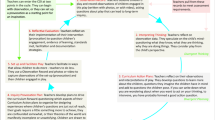Abstract
Drawing offers a powerful mode for representing and clarifying one‘s own thinking and for communicating ideas to others. Young children instinctively use drawing in the same exploratory way that designers use sketching to ’converse with themselves‘ when generating ideas. The two distinctive traditions of drawing in Technology and Fine Art are replicated in the Design and Technology and Art and Design curricula in England and Wales. However, because we lack research evidence about (i) the processes by which children develop drawing capability and (ii) the effects of school culture and pedagogy on the development of children‘s drawing capability, teachers are confused about how to teach drawing and unsure about the role of graphicacy in promoting children‘s learning in both subjects. In this article the particular dilemmas of teaching design drawing to young children will be discussed. A research agenda for the teaching and learning of drawing in primary schools will be outlined.
Similar content being viewed by others
REFERENCES
Alexander, R. J.: 1992, Policy and Practice in Primary Education, Routledge, London.
Banta, M. A.: 1980, Unit Blocks: A Curriculum for Early Learning, The Early Childhood Learning Centre, Department of Early Childhood Education, University of the District of Columbia, New York: ERIC Doc 206401.
Baynes, K. & Pugh, F.: 1981, The Art of the Engineer, Lutterworth Press, Cambridge.
Berger, J.: 1972, Ways of Seeing, Penguin, Harmondsworth.
Camp, J.: 1984, Draw: How to Master the Art, Andre Deutsch, London.
Cox, M.: 1992, Children’s Drawings, Penguin, Harmondsworth.
Cox, M.: 1991, The Child’s Point of View, Harvester, Wheatsheaf, Hemel Hempstead.
Cox, M. V., Eames, K. & Cooke, G.: 1994, ‘The Teaching of Drawing in the Infants School: An Evaluation of the ‘Negotiated Drawing’ Approach’, International Journal of Early Years Education 2(3), 68–83.
Curtis, J. & Boultwood, M. E. A.: 1962, An Introductory History of English Education since 1800, Second Edition, University Tutorial Press, London.
DES: 1991, Art for Ages 5–14. National Curriculum Proposals, HMSO, London.
DFE/WO: 1995, Design and Technology in the National Curriculum, HMSO, London.
DFE: 1995, Art in the National Curriculum, HMSO, London.
Edwards, C., Gandini, L. & Forman, G. (eds.): 1993, The Hundred Languages of Children: The Reggio Emilia Approach to Early Childhood Education, Ablex Publishing Company, Norwood, New Jersey.
Eisner, E.: 1972, Educating Artistic Vision, Collier Macmillan, New York.
Ferguson, E. S.: 1993, Engineering and the Mind’s Eye, The MIT Press, Cambridge, Masachusetts.
Fish, J. & Scrivener, S.: 1990, ‘Amplifying the Mind’s Eye: Sketching and Visual Cognition’, Leonardo 23(1), 117–126.
Freeman, N. H.: 1980, Strategies of Representation in Young Children, Academic Press, London.
Friere, P.: 1971, Pedagogy of the Oppressed, Seabury Press, New York.
Gardner, H.: 1993, Frames of Mind. The Theory of Multiple Intelligences, Second Edition, Fontana Press, London.
Gardner, H.: 1993, The Unschooled Mind. How Children Think and How Schools Should Teach, Fontana Press, London.
Garner, S.: 1992, ‘The Undervalued Role of Drawing in Design’, in D. Thistlewood (ed.), Drawing: Research and Development, Longman in Association with the National Society for Education in Art and Design, Harlow.
Gura, P.: 1992, Explaining Learning. Young Children and Block Play, Paul Chapman Publishing, London.
Henderson, K: 1991, ‘Flexible Sketches and Inflexible Data Bases: Visual Communication, Conscription Devices and Boundary Objects’, Design Engineering Science, Technology and Human Values 16(4), 448–473.
Kellogg, R.: 1969, Analyzing Children’s Art, National Press Books, Palo Alto, California.
Kimbell, R., Stables, K. & Green, R.: 1996, Understanding Practice in Design and Technology, Open University Press, Buckingham.
Kimbell, R., Stables, K., Wheeler, T., Wozniak, A. & Kelly, V.: 1991, The Assessment of Performance in Design and Technology: The Final Report of the Design and Technology APU Project, Evaluation and Monitoring Unit: Schools Examination and Assessment Council, London.
Layton, D.: 1996, Unpublished letter to the author.
Lowenfeld, V. & Brittain, W. L.: 1987, Creative and Mental Growth, Macmillan New York.
Luquet, G. H.: 1927, Le Dessin Enfantin, Paris. Alcan Luquet defined three stages in the development of drawing up to the ages of 7 or 8–pre-representational, intellectual realism and visual realism.
Malaguzzi L.: (ed.) (1987), I Cento Linguaggi dei Bambini, The Hundred Lanugages of Children, Assessorato all ‘istruzione, Reggio Emilia (Published in Italian & English).
Matthews, J.: 1994, Helping Children to Draw and Paint in Early Childhood, Hodder and Stoughton, London.
Medway, P.: 1995, ‘Virtual and Material Buildings: Language and Drawing in Architectural Construction’, Unpublished Paper, Centre for Research on Language in Education, Carleton University, Ottawa.
Medway, P.: 1996, ‘Writing, Speaking and Drawing. The Distribution of Meaning in Architects’ Communication’, in M. Sharples & T. van der Geest (eds.), The New Writing Environment. Writers at Work in a World of Technology, Springer Verlag, London, 25–42.
Mortimore, P., Sammons, P., Stoll, L., Lewis, D. & Ecob, R.: 1988, School Matters. The Junior Years, Open Books, London.
Perry, L.: 1992, ‘Towards a Definition of Drawing’, in D. Thistlewood (ed.), Drawing: Research and Development, Longman for National Society for Education In Art and Design, Harlow.
Robinson, K.: 1982, The Arts in Schools. Principles, Practice and Provision. The Gulbenkian Report, Calouste Gulbenkian Foundation, London.
Tizard, B., Blatchford, P., Burke, J., Farquar, C. & Plewis, I.:1988, Young Children at School in the Inner City, Lawrence Erlbaum, Hove.
Tomlinson, R.D.: 1947, Children as Artists, Penguin, London.
Vygotsky, L.S.: 1978, The Prehistory of Written Language in Mind in Society: The Development of Higher Psychological Processes, Harvard University Press, Cambridge MA.
Willats, J.: 1977, The Child’s Representation of the World, Plenum Press, New York.
Willats, J.: 1995, Recorded in Open University Production, ‘Windows on the Mind’, Open University.
Winner, E.: 1989, ‘How Can Chinese Children Draw So Well?’, Journal of Aesthetic Education 22, 17–34.
Author information
Authors and Affiliations
Rights and permissions
About this article
Cite this article
Anning , A. Drawing Out Ideas: Graphicacy and Young Children. International Journal of Technology and Design Education 7, 219–239 (1997). https://doi.org/10.1023/A:1008824921210
Issue Date:
DOI: https://doi.org/10.1023/A:1008824921210




